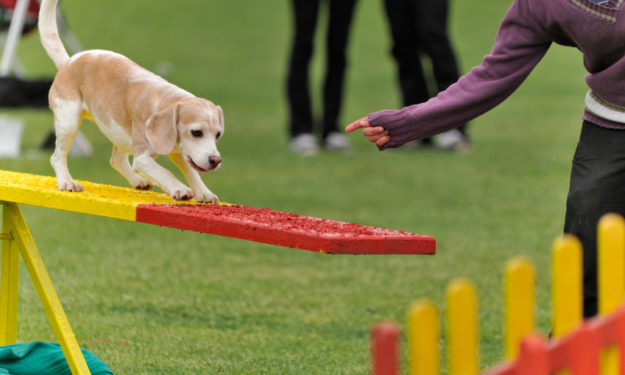A survey of risk factors for digit injuries among dogs training and competing in agility events

This article was published in JAVMA
January 1, 2018, Vol. 252, No. 1, Pages 75-83
Authors: Debra C. Sellon DVM, PhD, Katherine Martucci, DVM; John R. Wenz, DVM, MS; Denis J. Marcellin-Little, DEDV; Michelle Powers, DVM, MS; Kimberley L. Cullen, PhD
Department of Veterinary Clinical Sciences, College of Veterinary Medicine, Washington State University, Pullman, WA 99164. (Sellon, Martucci, Wenz); Department of Clinical Sciences, College of Veterinary Medicine, North Carolina State University, Raleigh, NC 27607. (Marcellin-Little); Massachusetts Veterinary Referral Hospital, 20 Cabot Rd, Woburn, MA 01801. (Powers); Institute for Work and Health, 481 University Ave, Ste 800, Toronto, ON M5G 2E9 Canada. (Cullen)
OBJECTIVE To identify potential risk factors for digit injuries in dogs training and competing in agility events.
DESIGN Internet-based, retrospective, cross-sectional survey.
ANIMALS 1,081 dogs training or competing in agility events.
PROCEDURES Data were collected for eligible animals via retrospective surveys distributed electronically to handlers of dogs participating in agility-related activities. Variables evaluated included demographic (handlers) and signalment (dogs) information, physical characteristics of dogs, and injury characteristics. A separate survey of dogs competing in similar agility-related activities but without digit injuries was also administered. Multivariable logistic regression was used to develop a model for assessment of risk factors.
RESULTS Data were collected from 207 agility dogs with digit injuries and 874 agility dogs without digit injuries. Factors associated with significantly increased odds of injury included Border Collie breed (OR, 2.3; 95% confidence interval [CI], 1.5 to 3.3), long nails (OR, 2.4; 95% CI, 1.3 to 4.5), absence of front dewclaws (OR, 1.9; 95% CI, 1.3 to 2.6), and greater weight-to-height ratio (OR, 1.5; 95% CI, 1.1 to 2.0). Odds of injury decreased with increasing age of the dog (OR, 0.8; 95% CI, 0.76 to 0.86).
CONCLUSIONS AND CLINICAL RELEVANCE Results should be cautiously interpreted because of potential respondent and recall bias and lack of review of medical records. Nevertheless, results suggested that retaining healthy dewclaws, maintaining lean body mass, and trimming nails short for training and competition may decrease the likelihood of digit injuries. Research to investigate training practices, obstacle construction specifcations, and surface considerations for dogs competing in agility activities is indicated.